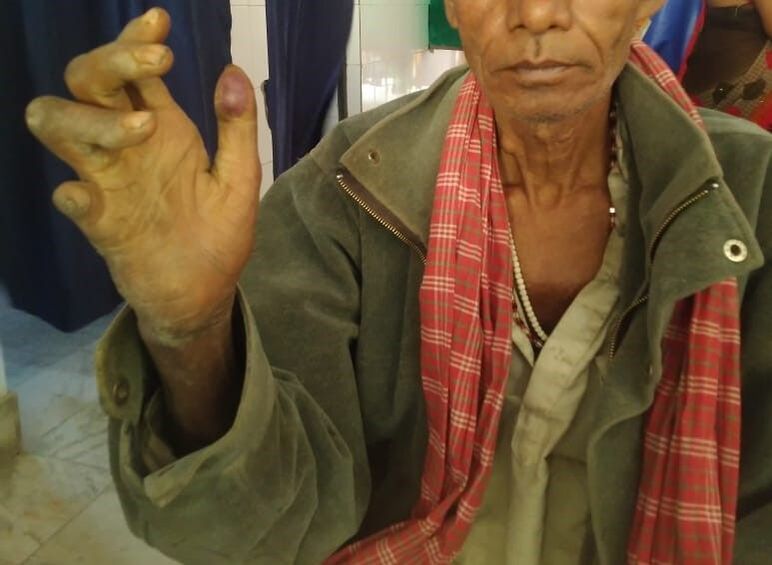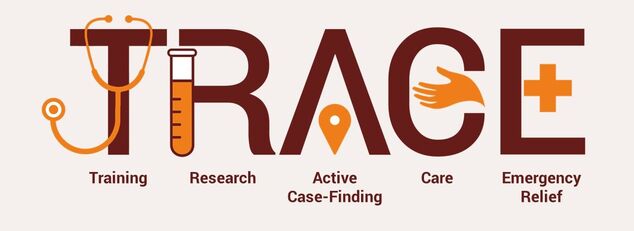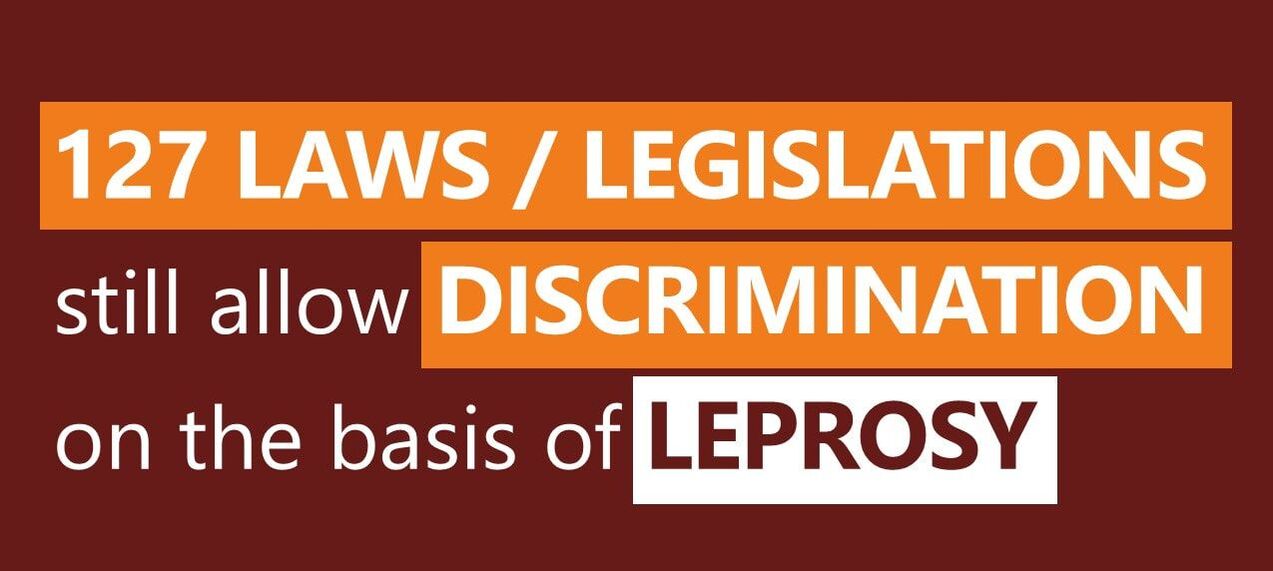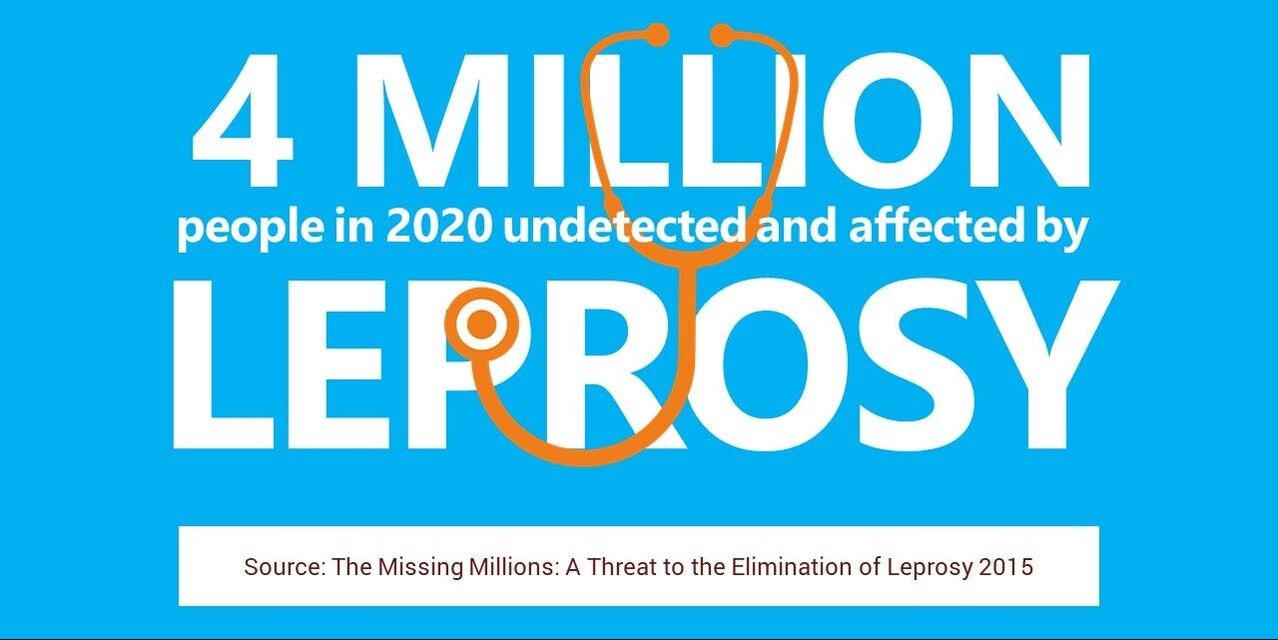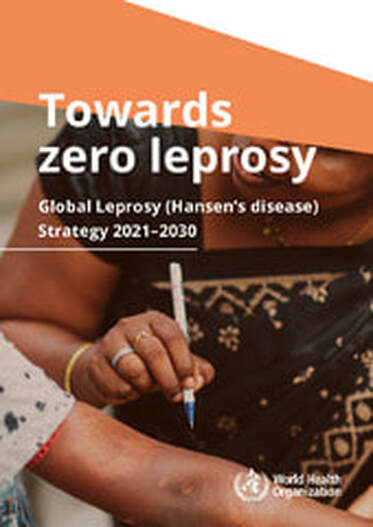|
Leprosy, also known as Hansen’s disease, is caused by the Mycobacterium leprae bacteria.
It affects the skin, the upper respiratory tract and peripheral nerves in the hands and feet, and the eyes. Leprosy can affect anyone, at any age, but it is linked to poverty, malnutrition and unsafe drinking water. If leprosy is diagnosed and treated soon enough, it will not cause terrible disabilities. Leprosy is one of the most stigmatised diseases on earth. |
Transmission
There is a widespread fear that leprosy is a highly contagious disease. In reality, it is difficult to catch leprosy. 95% of us are naturally immune. While doctors and scientists are unsure how leprosy is spread, it is thought through airborne droplet infection such as coughing and sneezing. Prolonged and close contact between people may also contribute. People with depleted immune systems, and poor nutrition, water, sanitation and hygiene, are more likely to catch it.
There is a widespread fear that leprosy is a highly contagious disease. In reality, it is difficult to catch leprosy. 95% of us are naturally immune. While doctors and scientists are unsure how leprosy is spread, it is thought through airborne droplet infection such as coughing and sneezing. Prolonged and close contact between people may also contribute. People with depleted immune systems, and poor nutrition, water, sanitation and hygiene, are more likely to catch it.
|
From the mid-1980s, leprosy has been treated successfully by Multidrug Therapy ("MDT".) MDT consists of the generic drugs: dapsone, rifampicin and clofazimine. Treatment with MDT lasts from six months for a mild, early case of leprosy to over 12 months for an advanced case.
Since 1995, the Novartis Foundation has donated MDT at no cost to patients. The World Health Organization distributes MDT to countries where leprosy is endemic or has endemic pockets. Leprosy initially presents on the skin as numb patches. It is hard to diagnose because it is easily misdiagnosed as other skin complaints such as eczema. |
|
Disability
If left undiagnosed, leprosy attacks nerve endings, destroying the ability to feel pain and injury. This lack of sensation makes patients susceptible to ulcers and infections. Over time, if left untreated, these ulcers can lead to the loss of fingers, hands, toes, and feet. Even those treated for leprosy and who are no longer infectious, can still develop ulcers over their lifetime. Leprosy can also cause blindness, facial disfigurement and the clawing of hands and feet.
|
SFLG’s operating strategy is putting an emphasis on case-finding and early detection followed by quick effective treatment, reflecting new global approaches in the ongoing fight against the disease. Read more about TRACE.
Leprosy causes more physical deformity than other infectious diseases. WHO Weekly Epidemiological Record 4 September 2020"
Discrimination
In addition, outdated laws mean that people with leprosy can be forcibly pushed out of their homes, livelihoods, and places of work. In some parts of the world, leprosy is grounds for divorce. Due to this terrible injustice, people with leprosy may not come forwards for medical treatment, putting themselves, their families, and communities at greater risk.
To find more about discrimination against people affected by leprosy please visit the ILEP website.
Click here for more Leprosy Q&A.
To find more about discrimination against people affected by leprosy please visit the ILEP website.
Click here for more Leprosy Q&A.
Select publications on leprosy
The real numbers affected by leprosy
Around 200,000 new cases of leprosy are diagnosed every year but the actual number of people at risk from leprosy or living with the effects of leprosy, such as blindness, amputated limbs or, its stigma and discrimination, is estimated at many millions more.
Download PDF Millions at risk of developing leprosy: a new study predicts 40 million people need preventative treatment to eliminate leprosy in 20 years. NRL and Erasmus University
Download PDF The Missing Millions: a threat to the elimination of leprosy. William Cairns Smith et al.
Download PDF The Missing Millions: a threat to the elimination of leprosy. William Cairns Smith et al.
|
Leprosy statistics and WHO Global Leprosy Strategy
The WHO global target of elimination of leprosy as a public health problem (prevalence of less than one case per ten thousand population) was achieved by 2000. However, there are still 23 global priority countries that are endemic for leprosy. Download the latest report here: World Health Organization Weekly Epidemiological Record 15 September 2023 The Global Leprosy Strategy 2021–2030 Towards zero leprosy was developed through a broad consultative process with all major stakeholders during 2019. Read more here: Towards zero leprosy. Global leprosy (Hansen’s Disease) strategy 2021–2030 |
Leprosy and COVID-19
The absence of antiviral drugs and the speed of COVID-19 transmission have had a major impact on public health systems worldwide, leading to the almost total collapse of many national and local healthcare services. Only time will tell how or if people with leprosy survive the COVID-19 pandemic. Read more about COVID-19, leprosy and neutrophils
The absence of antiviral drugs and the speed of COVID-19 transmission have had a major impact on public health systems worldwide, leading to the almost total collapse of many national and local healthcare services. Only time will tell how or if people with leprosy survive the COVID-19 pandemic. Read more about COVID-19, leprosy and neutrophils
Diagnostic test for leprosy
Although leprosy prevalence has declined from around 5.2 million globally in 1980s, annual case detection rates remain high at more than 200,000 per year. This number indicates that additional leprosy control strategies are required to stop transmission. Read more here: Leprosy Diagnostic test development as a prerequisite towards elimination Edith Roset Bahmanyar, William Cairns Smith, Patrick Brennan, Ray Cummings, Malcolm Duthrie, Jan Hendrik Richardus, Paul Saunderson, Tim Shwe, Steve Rosen, Annemieke Geluk.
Although leprosy prevalence has declined from around 5.2 million globally in 1980s, annual case detection rates remain high at more than 200,000 per year. This number indicates that additional leprosy control strategies are required to stop transmission. Read more here: Leprosy Diagnostic test development as a prerequisite towards elimination Edith Roset Bahmanyar, William Cairns Smith, Patrick Brennan, Ray Cummings, Malcolm Duthrie, Jan Hendrik Richardus, Paul Saunderson, Tim Shwe, Steve Rosen, Annemieke Geluk.
Women and leprosy diagnosis
Studies from around the world continue to show the disparity between the number of male and female patients being diagnosed with leprosy as well as suggesting that women are more likely to present later for treatment. Read more here:
Identifying the barriers to early case detection for women affected by leprosy Victoria G Price
Studies from around the world continue to show the disparity between the number of male and female patients being diagnosed with leprosy as well as suggesting that women are more likely to present later for treatment. Read more here:
Identifying the barriers to early case detection for women affected by leprosy Victoria G Price
I often talk about leprosy in terms of a motorcycle. The front wheel represents curing the disease and the rear wheel symbolizes ending discrimination. Only when both wheels are turning at the same time will we make progress towards our destination of a leprosy-free world. Yohei Sasakawa, WHO ambassador for the elimination of leprosy, 68th World Leprosy Day, January 2021.



